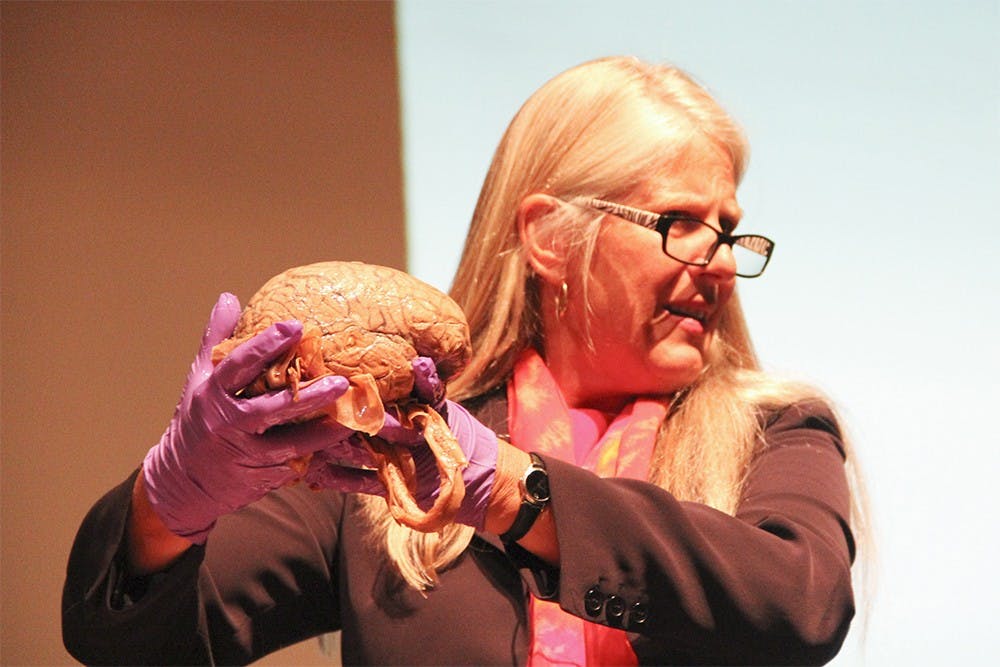Luckily for them, Dr. Jill Bolte Taylor was there to help.
In 1996, Taylor suffered a rare form of stroke that stripped her of the ability to walk, talk, read, write or remember her life.
It took the Harvard-trained neuroanatomist four years before she could again understand the concept of the number one.
Since her recovery, Taylor has written a book, “My Stroke of Insight,” which became a New York Times bestseller. She gave the first TED talk to ever go viral, and she was named one of TIME Magazine’s “100 Most Influential People” in 2008.
On Monday night, Taylor gave a presentation at Bloomington High School North titled, “Understanding the (Beautiful) Teenage Brain.”
She founded the not-for-profit, BRAINS, which is dedicated to “promoting brain awareness, appreciation, education, injury prevention, neurological recovery, and the value of movement on mental and physical health,” according to the event’s program.
“I think educating the community will help us relate to them better,” said attendee Tracey Hodge, the mother of an 18-year-old. “Even if we all were teenagers at some point, life happens and you start to forget how fun things were and the rush we got, so it’s good to be reminded.”
The majority of the presentation consisted of Taylor explaining how the human brain works in general, a task she did, in part, while holding an actual human brain in her hands.
Taylor explained that the most important relationship people have is the one between the character in their right brain, the nonverbal side that avoids confrontation and focuses on the present, and the character in their left brain, that seeks confrontation and focuses on the past and future.
If you’re in your left brain, Taylor said, you’d rather be right than happy, and if you’re in your right brain, you’d rather be happy than right.
Taylor described the one trillion cells and various parts that make up the brain.
“We would have to take each person on the planet and multiply them 143 times to match the number of living organisms making up your nervous system,” she said to give her audience perspective on the complexities.
She taught the crowd that each hemisphere in each of their brains has its own amygdala. This part of the brain is the one that is constantly asking, “Am I safe?”
If enough of the incoming information that the amygdala is screening is familiar, it deems that it is safe and allows the hippocampus to activate, giving humans the ability to learn, memorize and think in-depth thoughts.
Much of Taylor’s speech focused on people’s unique ability to control the neurological process going on in their brains. By understanding how they are wired, humans are able to distance themselves from their basic instincts and reactions and make a conscious choice on how to act.
“The human being is the only animal on the planet that we can instruct to take a breath, hold the breath, and let it out,” Taylor said, after having the audience do just that.
When a human thinks a thought, she said, it takes 90 seconds for them to attach an emotion to that thought and then have a physiological response to it.
The reason we’re able to hold onto those emotions for so much longer than 90 seconds is that we keep rethinking the thought to trigger the same emotion and the same reaction.
What many people don’t realize, Taylor said, is that humans have the ability to alter that emotional response.
“I knew that I could change my thoughts and my mind,” she said. “What I did not know was that I could change my emotional response. I thought my emotions were running the show.”
What Taylor calls the power of the 90 second rule, is the ability to look at your watch when you start to think something and watch the seconds tick by. In that way, she said, you can start to observe your circuitry rather than engage with it.
“I think it’s one of the biggest things that can change your life,” she said.
Eventually Taylor began to shift the conversation to young people.
When a human is born, it spends the first ten years of its life pretty much only thinking of her- or himself.
Then, a few years before puberty kicks in, the brain realizes that it’s only job as a human is to reproduce, Taylor said. And, in order to do that, it’s going to have to engage more with the outside world.
Then things start to get really crazy, according to Taylor.
Puberty hits accompanied by a physical growth spurt, which makes the amygdala panic.
“I’m unfamiliar,” Taylor squealed, impersonating an amygdala. “Help.”
Hormones begin to start gushing through the body, and then the teens (especially the males) grow testosterone receptors right on their amygdala, which makes them really angry for no logical reason.
“On top of all that there’s a pruning back of 50 percent of the cerebral cortex,” Taylor said. “They literally lose half their minds. And it is our job to love them.”
Taylor recommended encouraging teens to engage with their passions, because the teenage years are when most of their circuit wiring is being laid in their brains.
She also encouraged fostering a community more informed on mental health, noting that 25 percent of the population will experience a severe mental health crisis at some point.
“We have vulnerable children who, as a society, we need to be able to support,” she said.
For maintaining a healthy mental state, Taylor suggested sleeping enough, eating well, exercising and “choosing to stay out of our own way emotionally.”






